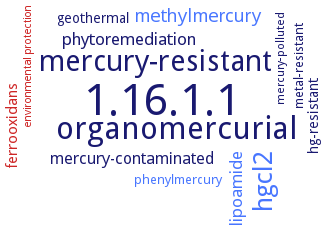1.16.1.1: mercury(II) reductase
This is an abbreviated version!
For detailed information about mercury(II) reductase, go to the full flat file.

Word Map on EC 1.16.1.1 
-
1.16.1.1
-
organomercurial
-
mercury-resistant
-
hgcl2
-
methylmercury
-
lipoamide
-
phytoremediation
-
mercury-contaminated
-
ferrooxidans
-
hg-resistant
-
geothermal
-
metal-resistant
-
phenylmercury
-
mercury-polluted
-
environmental protection
- 1.16.1.1
-
organomercurial
-
mercury-resistant
- hgcl2
- methylmercury
- lipoamide
-
phytoremediation
-
mercury-contaminated
- ferrooxidans
-
hg-resistant
-
geothermal
-
metal-resistant
- phenylmercury
-
mercury-polluted
- environmental protection
Reaction
Synonyms
bacterial mercuric reductase, Mer A, MerA, MerA protein, mercurate(II) reductase, mercuric (II) reductase, mercuric ion reductase, mercuric reductase, mercury reductase, Msed_1241, MseMerA, reduced NADP:mercuric ion oxidoreductase, reductase, mercurate(II), Rm CH34, Tn501 MerA, Tn501 mercuric ion reductase
ECTree
Advanced search results
Engineering
Engineering on EC 1.16.1.1 - mercury(II) reductase
Please wait a moment until all data is loaded. This message will disappear when all data is loaded.
C628A
-
HgX2 substrates with small ligands can rapidly access the redox-active cysteines in the absence of the C-terminal cysteines, but those with large ligands require the C-terminal cysteines for rapid access. The C-terminal cysteines play a critical role in removing the high-affinity ligands before Hg(II) reaches the redox-active cysteines
C629A
-
HgX2 substrates with small ligands can rapidly access the redox-active cysteines in the absence of the C-terminal cysteines, but those with large ligands require the C-terminal cysteines for rapid access. The C-terminal cysteines play a critical role in removing the high-affinity ligands before Hg(II) reaches the redox-active cysteines
Y264F
-
Km-value for Hg2+ is 5fold lower compared to the Km-value of the wild-type enzyme, turn-over number is reduced by 164fold
Y264F/Y605F
-
Km-value for Hg2+ is 5fold lower than the Km-value of the wild-type enzyme, turnover-number is reduced by 1091fold
Y605F
-
Km-value for Hg2+ is 1.3fold higher compared to the Km-value of the wild-type enzyme, turnover-number is reduced by 6.3fold
C628A
-
HgX2 substrates with small ligands can rapidly access the redox-active cysteines in the absence of the C-terminal cysteines, but those with large ligands require the C-terminal cysteines for rapid access. The C-terminal cysteines play a critical role in removing the high-affinity ligands before Hg(II) reaches the redox-active cysteines
-
C629A
-
HgX2 substrates with small ligands can rapidly access the redox-active cysteines in the absence of the C-terminal cysteines, but those with large ligands require the C-terminal cysteines for rapid access. The C-terminal cysteines play a critical role in removing the high-affinity ligands before Hg(II) reaches the redox-active cysteines
-
Y264F
-
Km-value for Hg2+ is 5fold lower compared to the Km-value of the wild-type enzyme, turn-over number is reduced by 164fold
-
Y264F/Y605F
-
Km-value for Hg2+ is 5fold lower than the Km-value of the wild-type enzyme, turnover-number is reduced by 1091fold
-
Y605F
-
Km-value for Hg2+ is 1.3fold higher compared to the Km-value of the wild-type enzyme, turnover-number is reduced by 6.3fold
-
C558A
-
mutation results in a total disruption of the Hg(II) detoxification pathway in vivo, compared to wild-type enzyme the mutant shows a 20fold reduction in turnover number and a 10fold increase in Km
C559A
-
mutation results in a total disruption of the Hg(II) detoxification pathway in vivo, compared to wild-type enzyme less than a 2fold reduction in turnover number and an increase in Km-value of 4-5fold
Y605H
-
24fold decrease in turnover number and a 15fold decrease in Km-value
E317V/F441Y
C11A
-
site-directed mutagenesis of NmerA residue of the metal binding site
C136A/C141A
-
site-directed mutagenesis, the C136A/C141A catalytic core mutant. Mutation of either C136 or C141 or both results in a total loss of Hg2+ reductase activity. CRystal structure determination with bound substrates
C14A
-
site-directed mutagenesis of NmerA residue of the metal binding site
Y62F
-
site-directed mutagenesis of NmerA residue of the metal binding site
E133G/E134G
site-directed mutagenesis, the mutant shows altered salt and metal resistance and temperature stability compared to the wild-type enzyme
E15A/E16A
site-directed mutagenesis, the mutant shows altered salt and metal resistance and temperature stability compared to the wild-type enzyme
E515A/E516A
site-directed mutagenesis, the mutant shows altered salt and metal resistance and temperature stability compared to the wild-type enzyme
E545A/E546A
site-directed mutagenesis, the mutant shows salt and metal resistance and temperature stability similar to the wild-type enzyme
K432L/P433D/A434L/R435T
site-directed mutagenesis, the mutant shows salt and metal resistance and temperature stability similar to the wild-type enzyme
K432L/P433D/A434L/R435T/K465D/V466S/G467R/K468T/F469L/P470T
site-directed mutagenesis, the mutant shows salt and metal resistance and temperature stability similar to the wild-type enzyme
additional information
mutant Tn501 MerA, structure comparison with the wild-type
E317V/F441Y
Metallosphaera sedula ATCC 51363 / DSM 5348 / JCM 9185 / NBRC 15509 / TH2
-
mutant Tn501 MerA, structure comparison with the wild-type
-
-
cloning and expression of catalytic core and N-terminal domain of enzyme as separate proteins. the N-terminal domain NmerA is a stable, soluble protein that binds 1 Hg2+ per domain and delivers it to the catalytic core at kinetically competent rates
additional information
-
cloning and expression of catalytic core and N-terminal domain of enzyme as separate proteins. the N-terminal domain NmerA is a stable, soluble protein that binds 1 Hg2+ per domain and delivers it to the catalytic core at kinetically competent rates
-
additional information
-
constitutive expression of enzyme in Pseudomonas putida results in a broad spectrum mercury resistance
additional information
mutations to substitute residues from the ATII-LCL MerA to their corresponding amino acids in the soil enzyme, overview


 results (
results ( results (
results ( top
top






